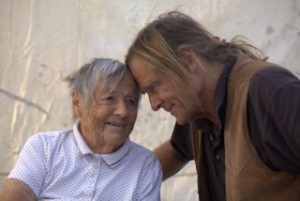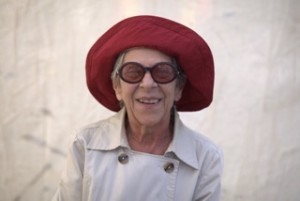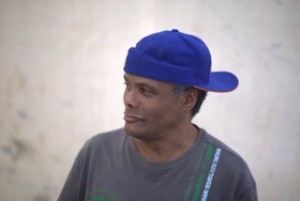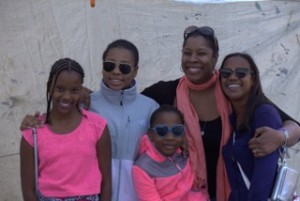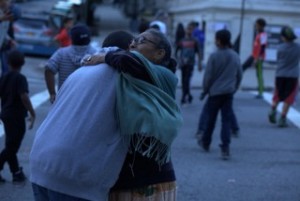“Loss of the past, whether it be collectively or individually, is the supreme human tragedy, and we have thrown ours away just like a child picking off the petals of a rose… We owe our respect to a collectivity, of whatever kind—country, family or any other—not for itself, but because it is food for a certain number of human souls.”—Simone Weil, “The Need for Roots”
Simone Weil once lived in a building around the corner from Tiemann Place in West Harlem where we held our 29th annual “Anti-Gentrification Street Fair” in October. (A plaque at 549 Riverside Drive commemorates dates of her residence there in 1942, before she went back to Europe where she martyred herself in solidarity with the French Resistance.) That on-the-corner conjuncture sparked this essay’s roots moves, which start uptown but end in (where else?) New Orleans.
I go to Memphis (among other places) in the meantime, thanks to Peter Guralnick’s new book, Sam Phillips, The Man Who Invented Rock ‘N’ Roll. And before I travel on, I want to acknowledge Guralnick’s “author’s note” on his latest attempt to cultivate America’s true vine has informed what jes grew here. Guralnick tells why Sam Phillips veered from the more objective, linear approach he’d taken in his celebrated biographies of Elvis Presley and Sam Cooke. He had to change it up in part because Phillips lived on long after rock ‘n’ roll jumped off. But there was another factor. Guralnick knew and loved Phillips and he wanted to let their friendship into his book. I skip around below and my own subject required bits of me too. Sam Phillips’ advice to Guralnick about how to write his life story seems right on point when it comes to the organic form I’ve tried on here. What I’ve gone for, per Phillips (and Guralnick), is “just another swinging day at the fair.”
I
After I posted this piece earlier this month, photographer David Hodgson emailed pictures he’d taken at our street fair on Tiemann Place. They seem to belong right here, right now so:
Our fair sustains a structure of feeling that’s lasted for decades—standing up to, or better, dancing around didacts for whom culture “is an instrument manipulated by teachers for manufacturing more teachers, who, in their turn, will manufacture still more teachers.” To quote a line from Weil’s The Need for Roots. Her testament could serve as a case statement for those of us who recall when our spot in West Harlem was more than a ghostly adjunct to Columbia University. We’ll keep searching for food that can’t be had in a hood being reduced to a genteel restaurant row catering to academics.
I once tried to make my own case for our Tiemann thing in an early issue of First of the Month:
Back on our block, [my brother] Tom and our friends invented a holiday. Last September we held our 13th annual Anti-Gentrification Street Fair. It’s a tradition that renews itself each year. Neighborly cooks spice up the food table with a Chicken Yassa (minus that damn vinegar) or a perfect Moussaka, a meringue band plays extra sets for free, a friendly pop critic donates bags of CDs for re-sale, two feuding neighbors bury the hatchet in a bottle of Babancourt, a dissipated rummy sobers up, a New York intellectual does hours of heavy lifting, a tenant organizer gives a sharp, short speech and I hear my Dominican-American nephew, who spoke Spanish shyly the year before, translating with ease.
I never will so I’ll always be a bit of a stranger to some folks who make our day. Like Enriquez, a muy macho music man and jack-of-all-trades (construction worker/photographer etc.) who usually provides our sound system. Enriquez once brought local color as an extra on an episode of a trashy tv show, “New York Undercover,” but he’s too large a character for tv. He likes to show off his strength—I’ve seen him lift a station-wagon by himself when we’re clearing cars from the street for our block party—and he tends to get angry when he starts pounding too many Buds. But I’ve never seen him bully anyone.
Enriquez used to call me “Maestro” when we’d meet on the street (and try to talk around his broken English and my hopeless Spanish). His bow to me affirmed his own culture because he knew I liked Afro-Latin music. It was also his way of expressing his feeling for my family. Enriquez realized my brother has spent a good part of his life fighting to keep our part of town from being gentrified. Since Tom deflects respect, Enriquez displaced esteem on to me. (And he’s not the only one who does that; one grandmother from the block calls me: “Little Tom”—pace Elvis.) Enriquez’s affectionate exaggerations, though, were big enough to contain skepticism—my bro married a neighborhood girl in the ‘70s, but what’s my white ass doing in the West Harlem Coalition?—as well as a measure of competitiveness. For years Enriquez and I have battled—side by side—at our street fair. The kids have their DJ, while he’s the Man for older Dominicans on the block. I tape up R&B, jazz, house, afro-pop, compas, reggae and rock ‘n’ roll for other tastes. When Enriquez is the master-musicker, meringue rules. I always put Latin tracks on my party tape, hoping to convince him to stay with it, but my aural diplomacy probably just makes him hungrier for his people’s music. Even if the block is rocking, he rarely lets my tape run more than 15 minutes.
There have been times, though, when I got more play at the fair than I’ll ever earn. One Falldown day, I watched from behind the rummage table, as my (too) young girlfriend mixed with my first black heart and the older woman I ran to after I broke up with my number one. As they chatted out of politesse towards un-feigned pleasure in each other’s neighborliness, I wondered what I’d done to deserve them. I wasn’t worried—no way these dreamy exemplars of three cohorts of Sisters were talking about my sorry body or soul. I just knew I was fucking lucky they’d had me in common. And I kept getting away it later that afternoon. My baby girl was feeling free and easy since my old(er) exes were definitely past tense so we broke for love. As we sped past kisses, I could hear Willie Colon’s “Asia” playing on my party tape through the open window. When it wafted into one of Enriquez’s speedy meringues, she came in a breeze. And kept coming. In a long hot rush to an elemental place where I could never go. Though it was at my fingertips; she never even used me all up in her. But I didn’t feel left out. I thanked heaven for letting her get some in my bedroom.
There’s no way I can compare my sacral instincts with Simone Weil’s. One of the great mystics of the 20th C., Weil became an unbaptized Christian, after growing up in a secular Jewish family. She agonized for years before choosing to stay outside the Catholic Church. (She was also keen on other religious traditions, though she resisted syncretism despite her who-feels-it-knows-it approach to divinity.) Her attempt to reconcile a Christian God with the reality of evil—like most high theology—is above my pay grade. But her notion of “decreation” hits me where I’ve lived. In her theodicy, God got real real gone…freeing us for good and evil: “God could create only by hiding himself.” The idea of a creator who ties his own dirty hands makes Weil’s God a sort of antithesis to today’s helicopter parents who hover over their children, never letting them alone. Weil’s own formidable mother seems to have been a trip, and Weil’s estranged God hints her need for roots coexisted with a yearning for freedom from Maman. (Her parents lived with her while she was at Riverside Drive.)
Such a thought comes unbidden to me in part because my own 91 year old mother looked on from the sidewalk at our last street fair, though she’s no madrona. My mom’s always known how to give her kids space to make messes and grow their own selves. (She was a natural-born gardener on the real side, and on the metaphorical tip.) My mom tires pretty easily now and shies away from loud music. After she got a little sun, my son walked her back to my brother’s apartment. My mom had been a trouper in the fair’s theater of comity but she wasn’t hanging tight for the encore. She doesn’t shuck us or herself. (Which is one reason why her sons have chosen life partners who are straight talkers.)
My mom told me recently her parenting days seem very far away. Her daughter-in-law Maria (my brother’s wife), OTOH, is now devoting much of her time to raising her son Jamie’s four year old daughter (who got happy at the fair). Maria’s readiness to take on a role played by so many grandmothers in Dominican families isn’t a sign she’s caved to the weight of the past. Maria was a Catholic school-girl and potential nun on the come, but she identified as a feminist early on. This tom-boy, b-ball player, and Beatles lover refused to give in to macho ways of being or gender rules in her hood. Her second motherhood isn’t a sign she’s made her peace with an oppressive cultural surround; it’s all about her own will to love (which is undaunted by serious medical challenges that may hinder her ability to live for others down the line).
The span of Maria’s lovesome life came home to me when I witnessed her encounter at the fair with my former competitor Enriquez. He may be on the verge of entering The Land of the Very Old, yet he lit up when he saw Maria. The years fell away from his face for a moment. (Maybe he was having a flashback, watching himself watching the young Maria when she was a muchacha on the block.) He bowed, then reached for her hand and, in a gallant gesture, brought the hollow of her wrist gently to his lips, let go and shuffled off. When I saw him tender his holy props to Maria de los Angeles he seemed to become an envoy from all her familiars who wish they could give it up to her no-quid-pro-quo soul.
II
My faith our block party would always be a time of gifts was shaken a few years ago. One fair day, only a dozen or so stragglers rolled by to share the pretty daze. Our “West Harlem Coalition” suddenly seemed like a zombie collectivity. (Even Simone Weil, who was loathe to trash any revivable local tradition, might’ve advised dead-enders to let it go.) I took the turnout as a sign we’d lost to urban gentry. There’s plenty of evidence to support that thesis. The neighborhood keeps getting paler and bourgie-er. Many Dominicans and Haitians have been pushed out, others have died off. But the fair’s flat-lining was also due to heavy changes in the life of my brother Tom, whom everyone had relied on to get our parties started. Tom had begun to suspect community organizing took too many evenings. Having retired from the Harlem P.O., he wanted to devote himself to making music, poetry/stories and drawing. (Simone Weil famously cultivated her own instinct for self-sacrifice yet there’s a passage of hers that speaks to my brother’s fear time wasn’t on his side: “Inspiration is a tension on the part of the soul’s faculties which renders possible the indispensable degree of concentration required for composition on a multiple plane…Whoever finds himself incapable of such concentration will one day acquire the capacity for it, if he perseveres humbly and patiently, and if he is impelled by a violent and unshakable desire.”) For a stretch, Tom felt ambivalent about his relation to the community he’d once been locked on, wondering if the needs of the many might be odds with his own imperatives. But he’s less stressed lately. This year, following the lead of a neighbor who’s long been an amanuensis of painters, he even managed to integrate art-making into the block-party. He brought out his own drawings and pasted up swatches of his writing, inviting others in the hood to go public with their compositions. A photographer, sketch artists, and a sculptor answered the Call. More makers may get drawn in next year. The future’s unseen, though. What matters now is how the street gallery inspired kids in the hood. A bunch of little ones, on a break from the bouncy castle, grabbed colored chalk that was lying around and went Basquiat on the block.
Those kids represent a third generation at the fair—sons and daughters of my nephew Jamie’s crew. He and his homies have got more into the tradition as they’ve become parents. And though the Street won’t loom as large in my own son’s head as it does in theirs, he may take something lasting away from the block party too. He had a full afternoon-into-eve at this last one, playing soccer-till-he-dropped. He began by getting schooled by a college age free-styler but ended up skilling clusters of other kids (and inspiring a 60 year old who joined the kick-around after racing home to get shod). When my son was seven or eight, he loved how the fair’s day-long ban on car traffic enabled him to whip down Tiemann Place’s hilly blocks on his scooter. But I bet he got a bigger rush from his soccer high, though he played most of the day on an incline. Those uphill contests proved his solo summer practice sessions hadn’t been a waste. And if my twelve year old ever recalls the glow he felt on the slope, he might find a message in his own mastery—one of the best parts of growing up, after all, is finding out what hills you’re meant to climb.
Though there are mountains beyond mountains for many kids. Like the developmentally challenged one from the projects across the street from Tiemann Place who keened for his (not all there) mom when another barefoot boy—no shoes allowed inside that air castle—started teasing him. A couple of elders tried to intervene, but it was the DJ who saved the afternoon by playing the kiddie dance hit, “Watch Me (Whip/Nae Nae).” When the (once-and-future?) bullied boy got into the groove with girls who did the stanky leg and bop, he seemed to shake off his fears (and his little tormentor).
It was the sort of swinging, healing scene that would’ve made the day of my old comrade Charles Keil—great American advocate of participatory peoples’ musics and dance cultures. For decades now he’s been committed to various forms of music education aimed at restoring…
that sense of a “bopi” [i.e., playground] where kids are autonomous and unsupervised and can mimic their elders in drumming and singing and dancing and not be interfered with. That to me is a little Eden that classless societies help to create for their children and that we don’t have. It’s just disappeared. We don’t have a clue to how that could work anymore. Keeping that lone flame alive is, to me, crucial.
You can hear why Keil has been a muse for those of us on Tiemann Place who mean to dance on. Keil has always been a visionary. (When he was just a grad student, he not only booked Malcolm X’s first academic debate, but also published Urban Blues—“a serious study of currently popular entertainers who earned good livings with electric guitars…that [in the words of one of the first rock critics] heartened a generation of like-minded listeners back when it still took chutzpah to admire James Joyce and James Brown in the same lifetime, much less the same sentence”).[1] Keil much prefers live music to mediated kinds, but his borntogroove facebook page instantiates a virtual, global flow of videos that links generations of groovers. (Bill Bailey moonwalks ahead of African kids jamming on the street etc.)
And, just in case you fear I’ve lost the thread—it’s not mad to link Keil to Simone Weil. Classical Greek paideia, with its focus on music, athletics and character-building, was/is a touchstone for both of them. Keil upholds Weil’s rad instinct to break down irreal abstractions. “The art of transposing truths is one of the most essential and least known” Weil once wrote and I think she might have dug the form (even if she felt pricked by the content) of this set of aphorisms by Keil:
Civilization is the crap that culture leaves behind.
Civilization, as a whole, piles up; culture gets smothered.
Being more civilized means having more museums and libraries; culture is giving yourself to prime and present time.
Conversation is culture; writing is civilized.
Culture is yeasty, fermenting, a single germ or seed generating a growth process; civilization is the wine bottled, labeled, and corked.
Improvising is cultural; following the letter of the law or the law of the letter is civilized.
Civilization is all grasp; culture is reach.
Lest anyone accuse me of overreach, I’ll allow the wannabe jolly persona of Charlie Keil—“that musicking man,” co-creator of “The Jubilation Foundation” etc.—is hard to square with that of Weil, who annihilated herself during World War II in a patriotic (and anorexic) fervor, and once confessed: “When I think of the Crucifixion, I commit the sin of envy.” I’m reminded, OTOH, of a section in a book co-written by Keil that included a discussion of a song (by Solidarnosc supporters out to bear witness to Poland’s agony in the 80s) titled, “The Crucifixion Polka.” No joke. Though you’re forgiven if those Poles evoke Mel Brooks’ riffs.
Keil’s efforts to translate his local Afro-Latin culturalism into a politics fit for America can make him seem nearly as extreme as Weil. A couple years back, per this post, Keil led a band—with him on tuba—that provided music at an event organized by the Vermont Independence Party whose objective is to secede from the United States. (Keil “fears that the USA is too big and too brittle and that downsizing is in order.”) Keil’s stranger ideological turns serve as a reminder Weil’s early exit ensured she never had to confront her own inevitable failure to translate The Need for Roots into a political program. She wrote the book to give the Resistance a clue about how to approach France’s regeneration—“France,” she wrote, “must become an inspiration before it can become a nation.” But her vision would never have appealed to constituencies that defined post-war French politics.
The difficulties of translating rootsy culturalism into national politics came alive for me when I found myself talking at the street fair with an old acquaintance from the hood who was feeling the Bern. He’d never been interested in politics before. For a sec, I thought Sanders backers might have a reason to cheer since their candidate had reached one of the disaffected. But, as our conversation went on, my neighbor’s politics got more dicey. It turned out he was a 9/11 Truther intrigued by a dozen other conspiracy theories. (He promised to link me to a site that proved video from Tahrir Square during the Egyptian Revolution was faked.) It’s not my neighbor’s regard for cranks (or Bernie), though, that I’ll recall down the line. What will stay with me is his readiness to pitch in at the fair. Out on the street early, he helped set up the sound system for the D.J. and a tent enabling a photographer to make dozens of portraits of partiers on our block. When the fair faded out, he helped with wrap-up (and clean up). His acts trumped his loopier views.
In another, better world it might be easier to derive a politics from the feel of communitarianism on Tiemann Place. But, for now, anyone in search of solidarity on our block can’t be too precious (or ambitious). Down here at our end of Claremont Ave, the point isn’t always to be the sort on whom nothing is lost. A lot must bounce off (as a First wit once had it). That brings me to the b-ball court in Amiri Baraka’s backyard at 808 South 10th St in Newark. Baraka’s home-base, visited by our crew a couple times over the years, provided a rich model of urban populism. Baraka, of course, could get cranky—flirting with 9/11 Truthers or talking up Mao Tse-Tung Thought. But his Mao-Mao-ing was overshadowed by his generous Juju. What’s more, his internationalist vagaries didn’t stop him from prepping future mayors of Newark (including the current one—his son Ras, who ain’t proposing to secede from New Jersey). Baraka’s own local Afro-Latin culturalism may have run even deeper than his politicking. He had a stage in his basement where blues people from Newark—ranging from elder jazz players to up-and-comers (like Lauryn Hill who grooved there before she was a Fugee)—performed. That basement space opened out on to the basketball court in his backyard. One of my favorite mementos is a photo Baraka took of Nina Simone (who lived with the Baraka family for a season) shooting a foul shot there. (Her form is fine—better than LeBron’s.) That snap captures the will to play at the performative core of Black Atlantic cultures, which both Baraka and Charles Keil have extolled. I’m reminded just now how those two spirits sparked my own (ex-baller) brother’s mid-life desire to get into the game as a musician/poet/colorist. (The poem of his up on this site now, which he pasted up next to the pics at our fair’s outdoor gallery, ends with a shout-out to Baraka.)
I’ve mentioned my son’s teaming up with soccer players on the block, but there were more b-ballers at our party. (This is New York, after all.) The hoop set up in the middle of the street concentrated attention of dozens of mannish boys who seemed to be shooting back at trends undermining the city game. Per Thomas Beller’s fine, felt elegy for playground ball, which tells how outdoor courts once packed with players tend to be empty now. (More anon.)
I took a couple shots myself. Swished one but doubt that’s what flashed me back to a blue sky day of ballin’ when I was twelve. I’ve often wondered why that episode got syndicated in my head and (inspired by my son’s play day at the fair?) it turns out there was an epiphany waiting at the top of the key. It was a sunny winterlude in that old memory—snow was melting and sap rising. I started my day in an empty gym shooting on my own, prepping for a rare Saturday afternoon game with my school team. The practice was its own reward. And my solos there segued into a sweet ride on the team bus looking out the window at picturesque Massachusetts hill towns that were shiny and new to me. The game at the end of trip turned out to be meaningful too, though only in retrospect. Doubt I played well—and can’t recall if my team won or lost—yet it became a game of my life—as I’ve now realized—when a ref called me for traveling after I dribbled behind my back. The ref may have simply blown the call, but b-ball courts were often places where culture wars played out in the 60s. There were arbiters—coaches and refs—who hated any unorthodox moves. That hill town ref may have felt an impulse to school a long-haired, wannabe blackish show-off from the college-town in the valley. (Bob Cousy to the contrary notwithstanding, certain moves were identified as Afro/counter-cultural back in that day.) And it seems he ended up teaching me a lesson, though it took me 40+ years to grasp. In the court of life, I’ve been fated to bump into lots of judges who disdain my way of being true to the game. But the trick has been to make sure they don’t keep me from going (around my back) where the fun is.
Let’s get back to the block, though, and the apparent decline of the city game. Tom Beller notes it makes sense to blame empty urban playgrounds on video games and the overall drift toward “Bowling Alone” in privatizing late capitalist contexts. But he zeroes in on a specific dollar-driven phenomenon undermining b-ball bopi. Kids with athletic talent are becoming meal tickets earlier on now as the number of paid coaches increases exponentially. Precocious players taken up by professionals seem poised to become lil’ meritocrats who look down on the amateurism of playground ball (and aim to avoid getting bruised on stony outdoor courts).
The process of financialization threatens to put a squeeze on one of the most enlivening aspects of the game—the range of wild styles you met up with on any urban court back in the day. When I was coming up, every Brother seemed to have an original way of handling or shooting the ball. Such jazzy ways of playing may get stiffed if coaches enforce standards too early.
I probably worry too much though. After all, the NBA star of the moment, Steph Curry, surely has style to burn. This story about his paideia is pretty Weily. It focuses on the backyard court where he learned the game shooting at a hoop his grandfather Jack had put up (originally for Steph’s father Dell who was the family’s first great NBA shooter):
Jack’s hoop was never much to look at. Its finest feature, by far, was the old reliable street lamp that hovered overhead and dutifully blinked on at dusk, bathing the key in warm yellow light. But this was Jack’s plan all along: Only people who truly loved the game and understood the commitment it required would stick past dark on his country court.
The soft wings of the backboard had more give than a fence gate. The thick steel rim offered no absolution; only shots placed perfectly in the middle of the cylinder passed through. The institutional green metal breaker box just behind the hoop gave off a constant static hum that lured a shooter’s focus away from the target. And the splintery wooden utility pole wasn’t squared to a single landmark—not the white ranch-style house, not the driveway, not the Blue Ridge mountains to the south or the creek to the north. So every shot required instant, expert recalibration.
The piece ends with a paean to that hoop that takes in the need for the roots:
“That old hoop is gonna be there for a long, long time,” Stephen says. “When my kids are old enough, I will definitely be passing it on. That will be a cool moment: getting to know what my dad felt like watching me learning to shoot on that hoop and what Grandpa Jack felt like watching my dad after he put it up.”
The net on Jack’s hoop is upside down. The wood is weathered and splintered. And over the years, as the area has grown, the utility pole has become covered in thick, black, twisted vines of cable and electric wire. Which means that even if you wanted to take down Jack’s hoop, you couldn’t. First, of course, you’d have to get past Grandma. What’s more, you’d have to disconnect the entire neighborhood, in more ways than one.
End of Part 1. Part 2 is posted here.
